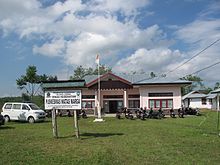Puskesmas
A Puskesmas ( Indonesian Pusat Kesehatan Masyarakat , German Communal Health Center ) is a state medical facility in Indonesia . It is operated by the Ministry of Health and offers the population health care at the district level (Kecamatan) . The concept was developed by Gerrit Augustinus Siwabessy , Indonesia's first health minister . There are also community and prevention programs. In 2014 there were 9718 puskesmas in the country, according to the Ministry of Health.
Overview
The municipal health system in Indonesia is structured on three levels. The puskesmas are at the top, followed by medical care centers ( Puskesmas Pembantu ) and midwifery centers ( Polindes ). They are usually manned by a doctor and a nurse (Bidan) and offer maternity care (including pre- and postnatal care), pediatrics , advice on family planning, outpatient care, preventive measures (such as vaccinations) and infectious disease control programs . There are also other clinic offers in larger facilities. A puskemas is planned for 30,000 residents. Puskesmas Pembantu support the Puskemas in geographical latitude. In megacities , Puskesmas support Pembina , intended for 150,000 people.
The care in the Puskesmas is mostly limited to a purely outpatient service. These puskesmas are usually only open until noon and cannot help with obstetric emergencies outside of the opening times . These puskesmas are often undersupplied and described as problematic, as patients with more serious illnesses are referred to higher levels, such as hospitals, without being given first aid or being transferred.
In sparsely populated regions, the Puskesmas sometimes also have beds and should be able to offer basic emergency care 24 hours a day with more staff and equipment. However, the staff often lack the knowledge, for example to help with gynecological emergencies. Here UNICEF helped with further training for staff.
A head of a puskesmas is headed by a head of administration. This is followed by the technical units I – III, the technical units IV – VII and a support unit.
Technical Unit I deals with gynecology and pediatric medicine, family planning and nutrition programs. Technical Unit II is used to prevent and combat infectious diseases. The task of technical unit III is dentistry, oral diseases as well as occupational and old-age diseases. Technical Unit IV is responsible for public health, conventional and sports medicine, mental illnesses, ophthalmology and special illnesses.
Technical Unit V takes care of buildings, the development of community health campaigns and public health advertising. The technical unit VI deals with outpatients and inpatients and the technical unit VII is responsible for the pharmacy.
Web links
Individual evidence
- ↑ a b Countrystudies: Indonesia - HEALTH , accessed November 7, 2018.
- ↑ DAFTAR PUSKESMAS DI INDONESIA KONDISI JUNE 2014 , accessed on November 7, 2018.
- ↑ a b c d Puskemas - The Priary Health Care System in Indonesia , accessed November 7, 2018.
- ↑ a b UNICEF: Maternal Health Component , accessed November 7, 2018.

